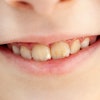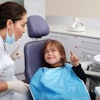
Early childhood caries (ECC) is a growing epidemic that could actually worsen under the provisions of the Patient Protection and Affordable Care Act (ACA), according to a new report by the American Academy of Pediatric Dentistry (AAPD).
The 13-page "State of Little Teeth Report" released on January 28 looked at who is most likely to suffer from caries; the disease's immediate and long-term health, social, and economic effects; and what's behind the epidemic. It also offers solutions for preventing caries among children, especially the importance of examining children by their first birthday and establishing dental homes for coordinated oral care.
In addition, the report looks at the ACA's potential for pediatric dental care and its shortcomings.
Caries, which is derived from the Latin word "carians" for decayed or rotten, has shown an alarming increase among very young children in the U.S. and around the world, especially among children from poor families, according to previous studies.
"It is a public health crisis that poses an immediate and long-term threat not just to the teeth of young children but to their overall health and development," the AAPD report noted.
Early childhood caries is now the most common chronic early childhood disease in the U.S., five times more common than asthma, ADA studies have shown.
The sobering statistics: ECC rates among children between age 2 and 5 increased almost 17% from 1988-1994 to 1999-2004. By age 5, a staggering 60% of U.S. children will have had caries, including the 40% of children who have it when they enter kindergarten, studies have found.
More than a quarter of California third-graders had untreated caries, according to a 2006 Dental Health Foundation report. In many cases, they were so severe that the children needed general anesthesia before having extensive treatment procedures.
The longer treatment is delayed, problems become more serious and difficult to treat, while access and costs multiply, the report noted.
Key factors, effects, and dangers
Poor children between ages 2 and 9 are twice as likely to have caries than those in higher economic groups, and the disease is more likely to go untreated, especially among minority kids. Poor diet and lack of education play a part in these disparities, the report stated.
"If baby teeth are lost early or broken down, the child's permanent teeth are more likely to erupt out of proper position or be impacted, leaving them more susceptible to caries and gum disease and subjecting the child to years of twisted teeth or orthodontia," the report explained.
“It is a public health crisis that poses an immediate and long-term threat not just to the teeth of young children but to their overall health and development.”
American Academy of Pediatric
Dentistry
Painful teeth makes it hurt to chew and can affect children's ability to sleep, pay attention in school, and attend school.
And the problem continues into adolescence: Some 80% of untreated caries in permanent teeth among children ages 5 to 17 are found mostly in low-income and other vulnerable groups, according to the report.
In addition to quality-of-life issues, treating caries is enormously expensive: More than $40 billion is spent annually for restorative and emergency care in the U.S.; Medicaid pays between $100 million and $400 million per year to treat ECC in children, the report noted.
Caries also makes children more vulnerable to various infections in other areas, including the ears, sinuses, and brain.
Perhaps the most tragic example of this was Deamonte Driver, a 12-year-old Maryland boy who died in 2007 after bacteria from an abscessed tooth spread to his brain.
Also, using drugs on children has risks, including overdoses that can suppress breathing. Recently, a 3-year-old girl went into cardiac arrest and died after being sedated with several drugs during an extensive dental procedure by a dentist in Hawaii.
In addition, failure to treat dental pain often has lifelong repercussions, such as developing fear and anxiety about visiting the dentist that may persist well into adulthood.
For many families, the key challenge is finding a dentist who will see their child. There are not enough dentists to treat very young children, especially those on Medicaid, the report noted. Only about 1 in 4 dentists accept Medicaid patients, mainly due to low reimbursements and burdensome paperwork, according to a 2007 ADA survey. And many who do take Medicaid patients decline to treat children, the report stated.
Prevention is paramount
One of the key reasons for the caries epidemic is that children are not seeing the dentist early enough, according to the report. The AAPD recommends that children get their first dental exam when their first tooth appears but no later than their first birthday. Surveys show that parents know it's important to take their children to the dentist by age one, but only 25% actually doing it.
"The early dental visit, combined with good dental habits and dietary practices, can slow or even reverse the caries epidemic among our children," the report pointed out.
"Our parents and caregivers need more education, but more education is not enough unless parents act on what they know," noted AAPD President Warren Brill, DMD.
But the report noted some good news: The number of uninsured children dropped 29% between 2000 and 2010.
Affordable Care Act
Many families will still have a hard time finding or paying for dental benefits for their children, the report noted, because the ACA, unlike its provisions for healthcare, does not do the following:
- Require consumers to buy standalone pediatric dental insurance as part of state healthcare exchanges
- Offer subsidies to help consumers pay for dental insurance
- Make improvements to Medicaid to increase dentist participation
In addition, the ACA does not fund the provisions it proposes to improve oral health, the report noted.
The law is expected to provide about 8.7 million children with some form of dental benefits, including 3.2 million children who could gain dental benefits through the Medicaid expansion. But access to care will be more difficult since the law will bring a large influx of children into Medicaid, an already overburdened and underfunded program with too few participating dentists, according to the report.
Midlevel providers (MLPs)
Many states are considering licensing midlevel providers -- similar to nurse practitioners -- to increase access to dental care, especially in school programs and nursing homes. However, the report pointed out an ADA study that concluded they do not reduce caries rates or oral health disparities.
Most dental associations, including the ADA and the AAPD, oppose midlevel providers.
"It would create a two-tiered standard of care in which the nation's most vulnerable children would receive services by providers with less education and experience," the report stated. Treating ECC often cannot be done by general practitioners or requires using drugs or hospitalization, which MLPs cannot provide, it noted.
"Perhaps the strongest arguments against use of midlevel providers to fix the damage of decay are the avoidance of significant investment in early prevention, the cost of repair, and the lifelong infection of those afflicted and their ongoing restorative dental burden," the report stated.
The AAPD instead suggests using expanded function dental assistants (EFDAs) to help dentists who serve populations who have trouble accessing dental care. EFDAs or dental hygienists with additional education can perform reversible, intraoral procedures under the supervision of dentists.
Recommendations
One of the key developments in promoting regular, preventive dental care is establishing a dental home, the AAPD noted. The concept provides an ongoing relationship between the dentist and the child in which all aspects of oral healthcare are delivered in a comprehensive, continuously accessible, coordinated, and family-centered way, according to the report.
"This is a way for all children, especially those who are vulnerable to oral health concerns due to their condition or background, to stay healthy," Dr. Brill said.
Currently, there are 6,134 pediatric dentists in the U.S., but it's not enough to meet the need, the report noted, especially because general dentists are much less likely to treat infants and toddlers. Pediatric dentists also get special training to allay children's fears, treat children with special needs, and adjust anesthesia doses.
Conclusion
Educating parents and medical providers about the importance of good oral health for children while involving allied health professionals and community organizations to prevent oral disease in young children will go a long way to solving ECC, the report concluded.
"Not only do ECC and other oral diseases threaten the immediate dental and overall health of these children, but they could have a lifelong impact on their dental and overall health and development. In addition, this public health threat will burden our society with substantial dental and healthcare costs, as well as social and economic costs," the AAPD stated. "The most encouraging -- and frustrating -- aspect of this healthcare crisis is that it is preventable."



















